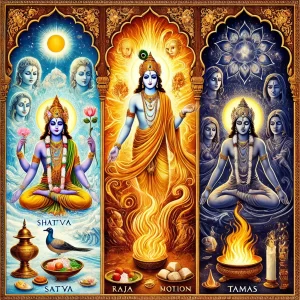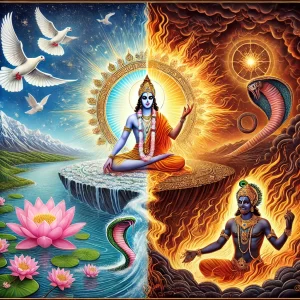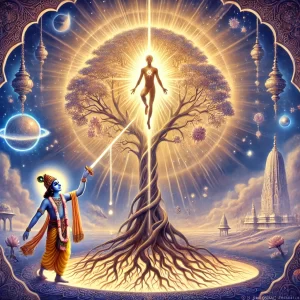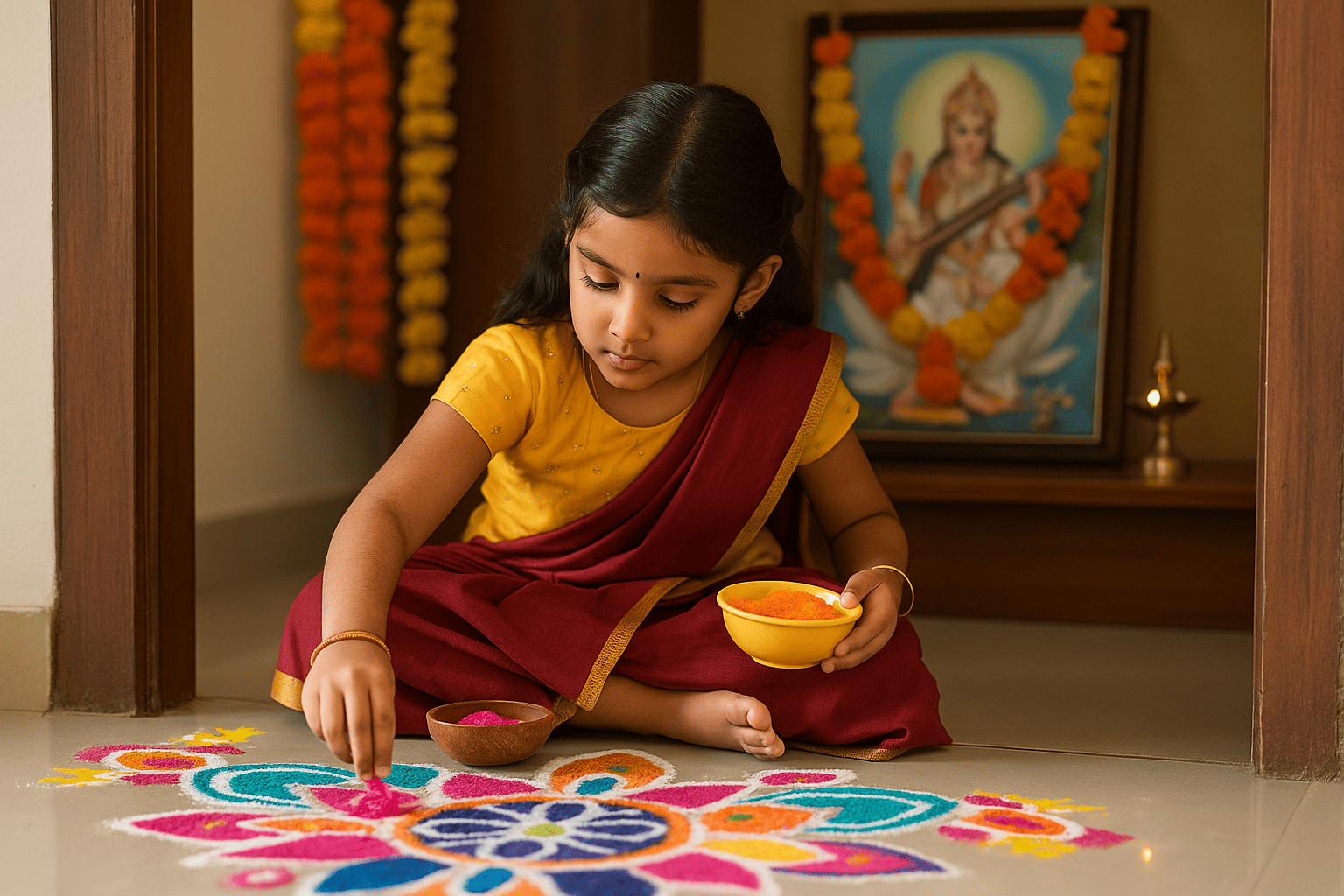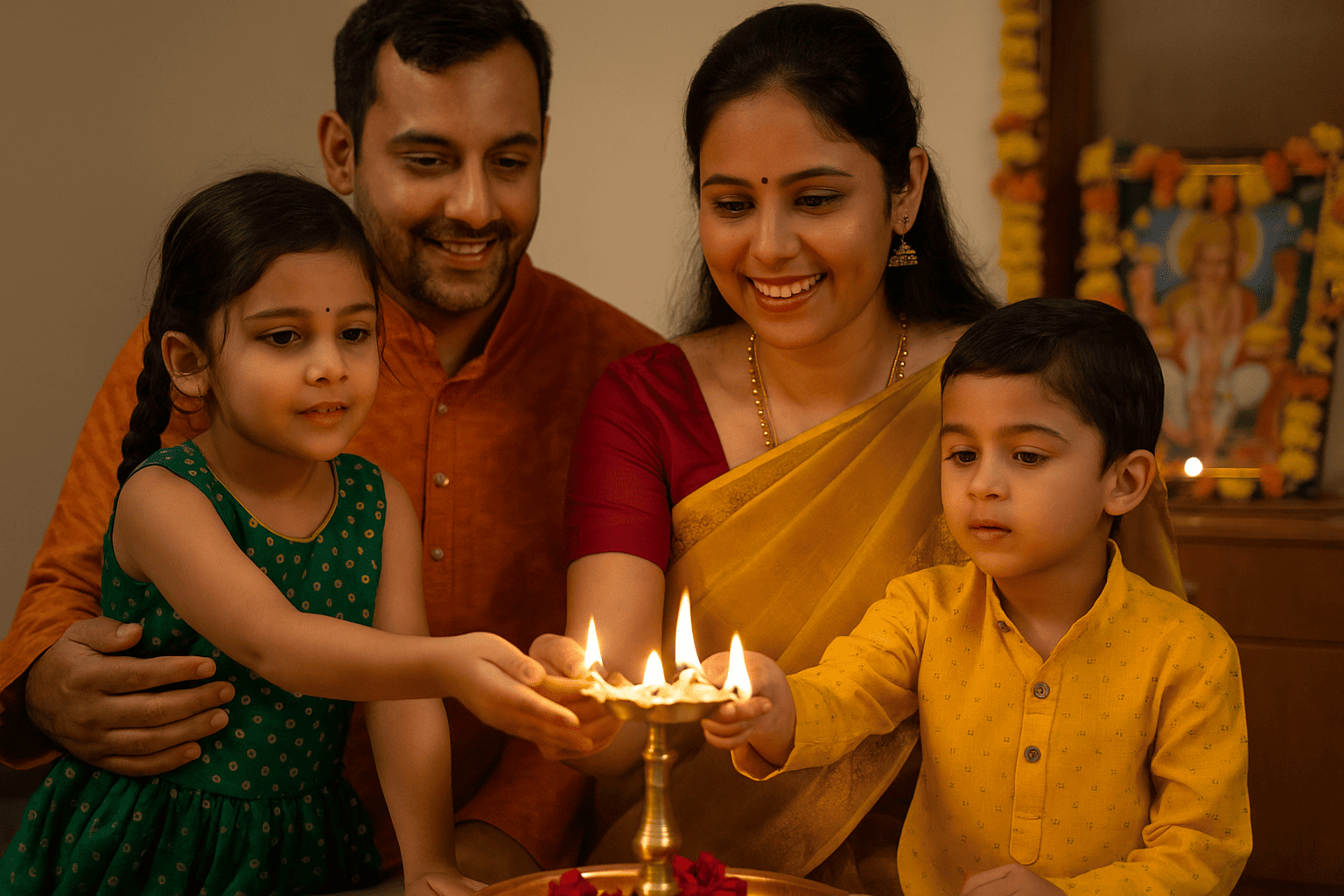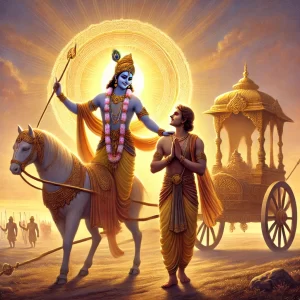
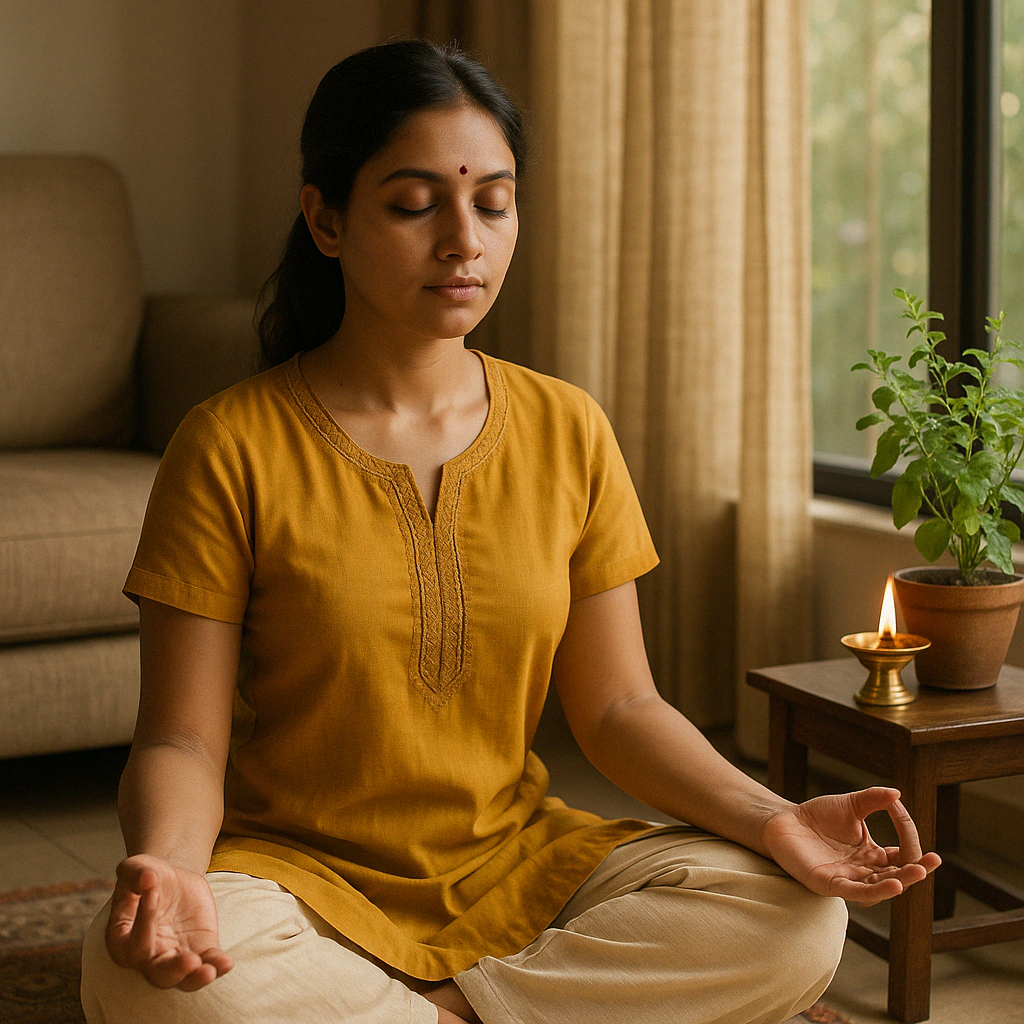
In the hush of early morning, while the world still sleeps and the first light is barely a whisper, an old woman sits cross-legged on the verandah of her home. The tiles are cold beneath her feet, and the breeze carries the scent of jasmine from the night before. Her eyes are closed, and a soft hum rises from her lips. It is not a song, not quite a prayer, but something in between—a sacred rhythm, vibrating from within.
This is where the story begins.
In Hinduism, dharma is often translated as duty or righteousness. But in truth, it is more expansive than either word conveys. Dharma is the invisible compass that orients a person toward harmony—with oneself, with others, and with the natural order. It is the subtle thread that weaves through our thoughts, actions, and choices, offering quiet guidance when the path is unclear.
In many traditional homes, elders understand this intuitively. For them, dharma is not performed in temples or declared in public. It is lived, gently and consistently, in the quiet corners of daily life. It is wiping the floor before placing a rangoli, as a sign of respect to the space. It is feeding the crow before eating, acknowledging the unseen. It is tending to the tulsi plant at dawn, not as superstition, but as communion—with earth, water, and breath. These aren’t chores. They are sacred gestures—rituals of alignment with nature, with spirit, and with self.
Dharma reveals itself in timing too. Knowing when to speak and when to stay silent. When to forgive, and when to take a stand. It manifests in relationships—not just in loyalty, but in truthfulness. Not just in sacrifice, but in balance.
For modern readers navigating fast-paced, complex lives, dharma can begin in small, conscious acts. Returning the grocery cart, not because it’s expected, but because it’s right. Honoring your word, even when it’s inconvenient, because integrity isn’t situational. Choosing kindness when no one is watching, not for praise, but because that moment asked for compassion.
Dharma is not about checking boxes or chasing virtue. It’s not about being perfect. It’s about being congruent. When your outer actions reflect your inner values, there is a quiet peace. A sense of walking in alignment with something older, wiser, and more lasting than trends or rules.
In this way, dharma becomes the bridge between philosophy and practice. Not a lofty ideal, but a lived experience. And in that experience, life itself becomes sacred.
There’s a story passed down in many homes: of a child who broke a bowl and buried the pieces in the garden. When found, the grandmother didn’t scold. She simply said, “Every action leaves a mark. Even the ones no one sees.”
That is the heart of karma.
Karma is not a ledger kept by some cosmic accountant. It is not about punishment or reward. It is about consequence—gentle, precise, and inevitable. Every thought, every word, every deed—each one sets something in motion. Karma is the subtle architecture behind the patterns of our lives. The shape of our relationships. The energy we bring into a room. The ease or heaviness with which we meet the day.
In the Hindu worldview, karma does not cast us into helpless cycles. It calls us to presence. It reminds us that no moment is wasted, and no choice is insignificant. Whether it’s helping someone without being asked, or harboring resentment quietly—these decisions leave imprints. Some on the world. Some on the soul.
When you respond with patience instead of anger, you don’t just avoid conflict—you plant seeds of calm that may bloom in ways you’ll never witness. When you give without expectation, you build an unseen bank of grace that holds you in your own moments of need. And when you harm, even in thought, that residue remains—not as divine punishment, but as weight carried in your posture, your tone, your silence.
Karma is not a trap. It is a tool.
It asks for no rituals. Only awareness. It asks us to slow down just enough to remember: This moment matters.
To live with karma in mind is not to tiptoe through life in fear. It is to walk with clarity, with ownership, with a sense of sacred responsibility.
Because every moment offers a choice. And every choice becomes a thread in the fabric of your future.
In many Indian households, the older generation gives things away easily. A sari to a neighbor. An old tin of sweets to the temple. A cherished lamp to a visiting relative. These acts aren’t done with reluctance. They are carried out with grace.
“Don’t get too attached,” they often say—not as a warning, but as a quiet form of wisdom. A kind of freedom.
Non-attachment—or vairagya—in Hindu philosophy doesn’t mean apathy or emotional coldness. It doesn’t mean not caring. Rather, it is the art of engaging deeply without clinging tightly. It is loving fully, without trying to possess. Striving hard, without becoming chained to the result. Mourning, without letting sorrow define your soul.
Non-attachment recognizes that everything in this world—relationships, success, even identity—is transient. And to flow with life, rather than be shattered by it, we must learn to hold gently, not grip tightly.
In our everyday lives, non-attachment can look like this:
This principle is not about becoming indifferent. It’s about becoming resilient. It’s about loving in a way that honors both your heart and theirs. It is the soft strength of saying, “I cherish this, but I do not own it.”
Non-attachment asks only that we stop confusing control with care. That we stop mistaking holding on with holding dear. That we release the need to possess what is beautiful in order to appreciate it.
And in doing so, we find a freedom that is light, strong, and beautifully human.
One morning walk, a teacher whispers, “Do you hear the sound of your breath? That is the voice of God within.”
Mindfulness in Hinduism isn’t a trend or a wellness hack. It is the original orientation of the soul. It is the ancient discipline of being fully here—rooted in the present, neither consumed by the past nor anxious about the future. From the sacred verses of the Upanishads to the battlefield wisdom of the Bhagavad Gita, the call has always been the same: Be present. Be aware. Be still.
Mindfulness is not something to achieve—it is something to remember. It is the natural state we return to when we quiet the noise.
In daily life, mindfulness is not limited to meditation cushions or spiritual retreats. It shows up in subtle, ordinary ways. Noticing the texture of your food before you eat it, instead of scrolling your phone. Feeling the sun on your skin before rushing to your car. Hearing the pause in a friend’s voice—and truly listening. Being with your children, your work, your breath—not just physically, but fully.
It is through mindfulness that we begin to reclaim the richness of the now. Not because the present moment is always pleasant—but because it is real. It is the only place where transformation is possible. The only place where healing begins.
Mindfulness is not an escape. It is a homecoming. A returning to the self that was never lost—just unheard beneath the static of distraction.
And it is in this spacious awareness that we begin to touch the essence of Atman—the true self. The witness behind thought. The light behind the eyes. The silent, observing presence that is not separate from the Divine, but an expression of it.
Hindu philosophy teaches that the Atman, the individual soul, is not separate from Brahman, the universal consciousness. This is not metaphor—it is the foundational truth upon which Vedantic wisdom rests. The same light that shines in the stars flickers in your own eyes. The same intelligence that orchestrates galaxies pulses quietly in your heartbeat. Divinity is not far away—it is intimate, embodied, immediate.
This realization, if truly felt—not just intellectually understood—can quietly revolutionize how we live. It changes the way we see others. No longer are people reduced to roles, labels, or reactions. If every being carries a spark of the Divine, how could we meet them with anything less than reverence?
It’s easy to say, but harder to live. Spiritual maturity begins to show when we resist the urge to retaliate. When we soften instead of harden. When we choose forgiveness not because it is deserved, but because we understand the damage of carrying bitterness. When we pause and say, even silently, “Maybe they’ve forgotten the light inside them. But I won’t forget mine.”
This is Vedanta in practice. Not in classrooms or chants alone, but in relationships. In daily struggles. In how we treat a stranger, a child, a difficult colleague. It’s not about renouncing the world—it’s about remembering who you are within it.
To walk through life with the awareness that you are not separate from the whole is to walk lightly, with humility and dignity. It means seeing the sacred everywhere—not just in temples, but in traffic, in mistakes, in moments of quiet understanding.
And in that awareness, the dance begins—not of ego, but of essence. A gentle rhythm that reconnects the soul to its source, again and again, in every breath, in every act, in every moment of being truly alive.
Spiritual integration doesn’t require dramatic change. It doesn’t ask for renunciation or grand rituals. It lives quietly, almost invisibly, in the small and seemingly mundane moments of our lives.
It’s in whispering a mantra before sending an important email—not to ask for success, but to centre your intention. It’s in placing a small diya at the window every Friday night—not as routine, but as a gesture of keeping light alive in the home and in the heart. It’s in volunteering without announcing it. In helping without expecting thanks. In giving your full presence to someone who needs to be heard.
In Hindu philosophy, the sacred does not exist only in temples or sacred texts. It is immanent—present in the sound of a conch shell, in the swirl of incense, in the act of tying your child’s shoelaces with love. Every act, no matter how trivial, has the potential to be spiritual if performed with awareness.
And when things fall apart—as they inevitably do—spirituality doesn’t demand denial. It invites you to stop seeking all answers outward. Instead, it gently nudges you to sit still. Breathe. Trust. The teachings remind us that everything is cyclical: joy and sorrow, gain and loss, clarity and confusion. The wheel will turn again.
To integrate Hindu principles into daily life does not mean changing your wardrobe or quoting Sanskrit verses. It means shifting the quality of your attention. It means treating the moments between tasks—the pauses, the silences, the transitions—with reverence.
Because it is in those ordinary moments that the extraordinary often reveals itself. And in honoring the sacred in the small, you begin to reshape your entire life into a living, breathing prayer.
You don’t need to live in an ashram to practice these truths. You don’t need to chant in Sanskrit or renounce the world. You don’t need a guru or a sacred retreat. You only need to begin—right where you are.
Because each of these moments holds the seed of moksha—liberation. Not liberation from life, but liberation within life. Liberation from restlessness, from forgetting, from the lie that the sacred is somewhere else.
True freedom isn’t a far-off reward. It is the stillness that grows when you live aligned with what matters. It is the quiet joy that lives inside you—steady, waiting, eternal.
When you begin to see divinity not just in temples but in tea-making, not just in prayers but in pauses, your whole life becomes sacred.
Nothing dramatic has changed. And yet, everything has. You are living from the inside out.
Let this be your reminder: You are not too modern to be mindful. You are not too busy to be kind. You are not too far from the sacred.
You are already on the path.
You always were.

